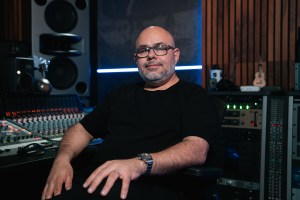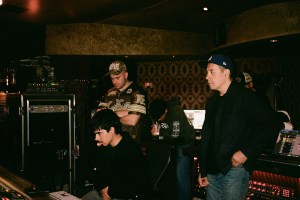Meet the Producers Making Regional Mexican Music Explode
For decades, a traditional (and, at times, formulaic) sound defined and powered regional Mexican music, the umbrella term that includes subgenres like banda, norteño and mariachi. But today, música mexicana, as it is also known, is booming (according to Luminate’s midyear music report, it fueled Latin music’s growth in the first six months of the year) in large part thanks to the limitless creative visions of its most prominent producers.
This school of hit-makers — who range widely in both style, from Jersey corridos to synth-powered regional ballads, and age — is crafting bold sounds and genre-spanning hybrids, setting the tone for an ever-evolving genre as it adapts to its new global appeal and reach.
Ernesto “Neto” Fernández

Ernesto “Neto” Fernández
Ed Visions
The Texas-born veteran has long defined regional Mexican movements, like the quebradita explosion of the 1990s. But when he tried to be “experimental” in the past, “it wasn’t accepted — our hands were tied,” says Fernández, 51. “Now everyone is open-minded and that helped me branch out.”
Among his biggest recent successes: Peso Pluma, whose swaggering lyrics and high-energy sound helped usher in a new era for regional Mexican music and whose signature style was heavily informed by working with the producer. “Very early on in the process, I start hearing and imagining where instruments will go,” explains Fernández, who incorporated charchetas (alto horns) and trombones into corridos tumbados, a subgenre that started with just guitars. “My part is to make sure that instruments don’t compete but to have them each have their own place. I like to hear things a certain way and how I want it to sound.”
It’s safe to say Fernández — who won producer of the year at the 2024 Billboard Latin Music Awards thanks to tracks he worked on for Peso and Xavi — knows a thing or two about what works and what doesn’t. Today, he’s one of regional Mexican music’s most trusted producers, also working with artists like Tito Double P.
Danny Felix

From right: Xavi, Danny Felix and Ivan, Xavi’s guitarist.
Paco Cajeme
Felix’s production career got off to an unorthodox start. “I was taking English songs and making them regional,” he says. “[Artificial intelligence] didn’t exist back then, so I remember one day, I found Beyoncé’s vocals on YouTube and followed along with a guitar. I was like, ‘This sounds cool.’ ” It sparked his passion for elevating songs with prickly acoustic guitars and led to him pioneering corridos tumbados and producing the subgenre’s first big star, Natanael Cano.
While guitar-driven subgenres like sierreño already existed, corridos tumbados’ guitars make heads bob like a hip-hop beat — even Bad Bunny couldn’t resist joining Cano on 2019’s Felix-produced “Soy el Diablo – Remix.” “Guitars are my thing,” adds the Arizona native, who’s in his early 30s. “People try to do what I do and I love that, but I have a unique way of hitting the strings that you can tell it’s me right away.”
The sound Felix developed has evolved over the years, with artists like Peso Pluma adding different instruments, and he has also adapted his guitars to singers he is producing for today, like Xavi, who pioneered tumbados románticos. “His range of singing is completely different,” Felix says, “so you have to play [the guitar] a certain way to complement his vocals.”
Armenta

Armenta
Epho
Penning and producing hits for Fuerza Regida like “Harley Quinn” and “Bebe Dame,” Armenta, 24, went from thinking a producer was mainly a beat-maker to understanding that there’s much more to the craft. “As a producer, you give it your soul, your essence, and when that goes hand in hand with songwriting, it becomes magic,” says Armenta, who has deviated from tradition by incorporating electronic music, loops and pads (or synthesizers) into his productions. “Everything used to be very rigid; the beats and rhythms were the same. Now it’s a genre for young people, and we achieved this through influences such as rap, hip-hop and other urban genres where it’s no longer just about making regional music but about making music, period.”
“Harley Quinn,” a 2023 collaboration with dance producer Marshmello, turned heads with its EDM-leaning sound. “We called it ‘Jersey corrido,’ ” Armenta says proudly. “In our search for the perfect harmony between house and EDM, we found this rhythm where we can play it with a tololoche [a Mexican folk instrument that is a variant of the double bass] and finish it off with charchetas. All the folklore that this song carries is very beautiful, and it really opened our eyes to the fact that the sky is the limit.”
Frank Rio

From left: Ivan Cornejo (seated); Frank Rio; Alejandro Cornejo, Ivan’s cousin and bassist; and engineer Manny Marroquín.
Ozzy Arias
A fan of the stripped-down melodic approach to regional Mexican music, Rio was eager to experiment with the style, but “I didn’t want to force it on anyone,” he says, having previously worked mainly with non-regional Mexican acts like A.Chal and Jhayco. Then he met Ivan Cornejo and they instantly connected. “We’re emo boys,” Rio says with a laugh. Cornejo’s stirring vocal delivery meshed perfectly with Rio’s equally emotional production style. “When I’m part of a record from start to finish, there’s definitely a lot of emotion,” says Rio, 32. “Whether sad, happy or in between, I always try to make it a journey.”
Cornejo’s brooding regional ballads with an alternative edge — like “La Última Vez,” one of the first songs he and Rio did together — defy música mexicana standards. “I don’t want to say I’m responsible for this new sound because I’m sure it wasn’t the first time someone had added synths to Mexican music, but for me, it was a big eye-opener about what you can do in Mexican music, and now it’s tough to identify what we do just as that,” Rio says. “It has never crossed my mind that I could have a limit, especially with Ivan. Focusing on [creative] freedom means constant experimentation in the studio with him. I’ll do four or five versions of a song, from alternative to sierreño, to find the version that works.”
Moises López

Moises López (second from left), Jesús Ortiz Paz (center) and artist Diego Millán (second from right).
Miguel Lopez
López never imagined getting into producing. But when he joined Fuerza Regida four years ago and got in the studio with the band, he saw producers create a song from start to finish and thought: “I can do that and I want my credit, too.”
While his career as a producer is only just starting — the 22-year-old was initially brought on as the band’s tololoche player and officially became one of its producers two years ago — López is already leaving a mark on regional Mexican thanks to his work on Fuerza Regida’s 2025 album, 111XPANTIA, which peaked at No. 2 on the Billboard 200, becoming the highest-charting Spanish-language album by a duo or group ever. “Building a song from scratch is like a puzzle,” says López, who gets animated talking about his work in the studio. “The goal for me is always to experiment and find what the next big sound or wave will be but also keeping our corridos roots.”
Fuerza’s producing crew — which also includes frontman Jesús Ortiz Paz — took it a bit further this time around, incorporating synths behind instruments for a punchier sound. It also did something the band had never done before: “We added samples from other genres,” López says. “In ‘Tu Sancho,’ you’ll hear Ellie Goulding’s ‘Don’t Say a Word.’ We realized it was time to add samples to our music, which will mark a major shift in our genre.”
This story appears in the Aug. 16, 2025, issue of Billboard.
Powered by Billboard.



